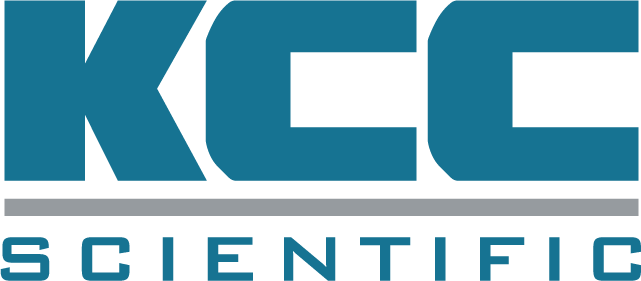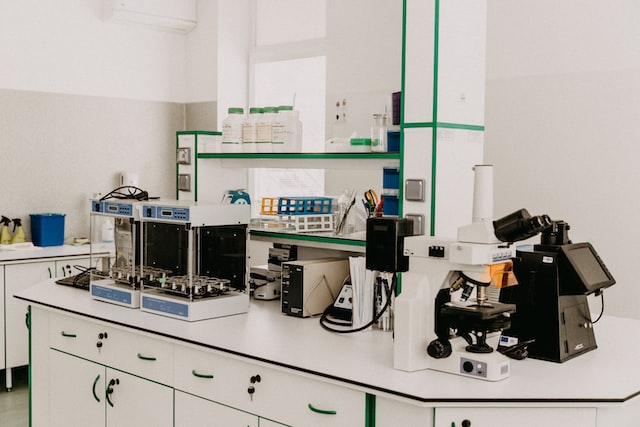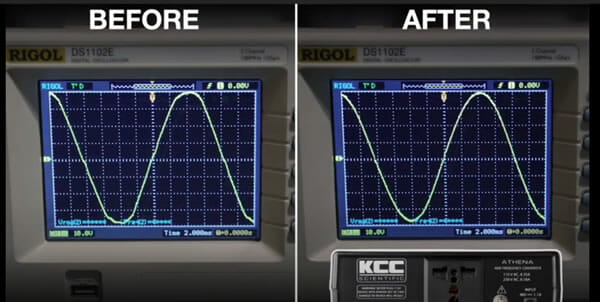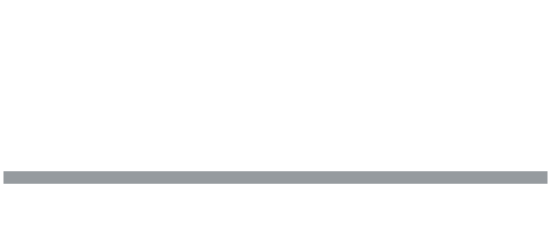[et_pb_section fb_built=”1″ _builder_version=”4.16″ global_colors_info=”{}”][et_pb_row _builder_version=”4.16″ background_size=”initial” background_position=”top_left” background_repeat=”repeat” global_colors_info=”{}”][et_pb_column type=”4_4″ _builder_version=”4.16″ custom_padding=”|||” global_colors_info=”{}” custom_padding__hover=”|||”][et_pb_text admin_label=”Article Content” _builder_version=”4.20.4″ background_size=”initial” background_position=”top_left” background_repeat=”repeat” global_colors_info=”{}”]
How to Protect University Laboratory Equipment by Using Clean Power
I. Introduction
A. Background information about university laboratories and equipment
University laboratories are an essential part of the learning process for undergraduate and graduate students and researchers. These laboratories are designed to provide students with hands-on experience and knowledge of specific scientific concepts, such as chemistry, biology, physics, and engineering. University laboratories are equipped with a range of specialized equipment and materials that are not typically available to the general public, such as microscopes, spectrometers, centrifuges, and computers with complex software. In addition to these tools, laboratories are also staffed with experienced faculty members, teaching assistants, and technicians who provide students with instruction, support, and expertise. The equipment in university laboratories varies depending on the discipline, research area, and level of study. However, regardless of the field of study, laboratories are a critical part of the university experience, allowing students to explore and understand the world around them through experiment, observation, and discovery.
B. Importance of protecting laboratory equipment
Laboratory equipment is an essential component of the scientific research process, and protecting this equipment is crucial for maintaining its accuracy and reliability. Lab equipment can be expensive, and replacing broken or damaged equipment can be costly, resulting in lost time, resources, and funding. Additionally, many laboratory procedures require precise measurements and controlled conditions, which are only possible with properly functioning, maintained and calibrated instruments. Protecting lab equipment also ensures the safety of lab workers, as faulty equipment can pose a risk of injury or even harm to laboratory samples. Therefore, it’s essential to implement regular maintenance and calibration measures, proper storage, and careful handling to keep the lab equipment functional, accurate, and safe. Investing in the protection of lab equipment reflects positively on the quality of research, efficiency, and safety standards in the laboratory.
II. What is clean power?
A. Definition and explanation of clean power
Clean power refers to the energy generated from renewable and sustainable sources that have minimal impact on the environment. This type of energy aims to reduce the emissions of greenhouse gases and pollutants that harm the environment and contribute to climate change. Clean power sources include wind, solar, hydro, geothermal, and biomass energy. For purposes of this article, we will refer to this as renewable clean power.
Clean power can also refer to the quality of the power being delivered at our outlets. In this evaluation, brown outs, drop outs, spikes, DC present on the line, frequency shifts, and other related aberrations can have deleterious affects on equipment plugged into outlets which are directly connected to the grid.
These two issues can actually be at odds. As we transition to renewable clean power, there is a learning curve. Smoothly transitioning to renewable clean power can be difficult, and problems can arise that affects the power as received at our outlets. Meanwhile, as the demands on the grid increase, we are already well aware that this directly impacts the quality of the power delivered at our outlets.
B. Benefits of using renewable clean power
There are numerous benefits to using clean power that make it a more viable option compared to traditional sources of energy. Renewable clean power offers a sustainable solution for energy production that reduces harmful emissions. This not only improves air quality but also helps to slow the effects of climate change. Technology improvements have also made it more accessible and efficient, leading to job creation and economic growth.
Thus it is important that we manage the quality of the power available at our outlets both now, during the transition to renewable clean power, and thereafter.
III. Common problems with laboratory equipment
A. Power surges, drops, frequency shifts, DC offsets
Power surges and drops can cause significant damage to electronic devices and appliances. A power surge is a sudden increase in voltage that lasts for a brief period, whereas a power drop is a sudden decrease in voltage that lasts for the same duration. Both can be caused by electric power grid failure, a sudden increase in electrical demand beyond the capacity of the grid, or even demands going on within the university or research facility. To ensure the sustainability of electronic devices and appliances, it is important to use a device which absorbs the excess voltage (or other aberration) from the surge and prevents it from reaching the device. Similarly, devices which provide voltage and frequency regulation can help in stabilizing fluctuations and ensuring the smooth functioning of electronic devices. Proper installation of such equipment and regular maintenance can prevent significant financial and operational losses due to power surges, voltage drops and frequency shifts.
B. Electrostatic discharge
Electrostatic discharge (ESD) occurs when two objects with different electrical charges come into contact, resulting in the flow of electrons from one object to the other. This phenomenon can pose a significant threat to electronic devices, as the discharge can damage or destroy sensitive components. Common sources of ESD include human contact with devices, particularly in dry environments where static buildup is more likely, and electrostatic build-up caused by friction. To prevent ESD damage, companies often implement protocols such as grounding equipment, using anti-static bags and wrist straps, and controlling humidity levels in the workplace. It is essential to take precautions against ESD, as repairs or replacements of damaged equipment can be costly and time-consuming.
IV. How to protect laboratory equipment with clean power
A. The use of an MRU (Mains Reconstruction Unit)
An MRU is an electrical device that provides complete reconstruction of the power at the outlet. It can be used to protect critical equipment like computers, servers, and large networks from power disruptions, such as outages, power surges, and voltage fluctuations. MRU’s devices are important for sensitive equipment that cannot tolerate power aberrations mentioned above. MRU’s improve power quality, reduce electrical noise from reaching the sensitive instrument, thereby enhancing the lifespan and efficiency of connected equipment.
B. UPS Devices
A UPS (uninterruptible power source) provides battery backup protection from power outages. This assures data integrity in the event that power is lost. Unfortunately, many of these devices do NOT provide mains reconstruction during normal operation, meaning that any power quality issue will find its way through to the sensitive laboratory instrument.
C. Surge protection devices
Surge protection devices are electronic tools designed to prevent damages caused by power surges, spikes, or transients, in electrical circuits, created by transient changes in voltage. Such surges can be caused by high-energy electrical factors, the most common being lightning. These devices can be installed in a wide variety of electrical equipment including home appliances, computers, and telecommunication systems. Their primary function is to route excess current to the ground or to stop it completely, ensuring that the equipment is protected from damage. Some devices can be installed in main power panels, offering facility-wide protection from strikes entering the work place to start with. These are often much more resilient to transient effects than the common devices built into power strips and similar.
D. Voltage regulation in the lab
Although voltage regulation is often important in residential settings, it is most crucial in any laboratory setting. Laboratories benefit from regulated voltage to ensure accurate and precise measurements, and to ensure the safe and proper functioning of all equipment. Voltage fluctuations (over voltage, under voltage or drop outs) can cause equipment to malfunction, leading to inaccurate readings and even damage to the equipment. Therefore, it is necessary to use voltage-regulating devices such as MRU’s to assure these effects never reach sensitive equipment in the laboratory. These devices help to protect laboratory equipment from spikes and surges in voltage while providing stable voltage levels. Voltage regulation is a critical element in ensuring that scientific research is carried out effectively and efficiently, providing accurate and reliable results.
V. Conclusion
A. Recap of the importance of clean power for laboratory equipment protection
It is essential to assure clean power for laboratory equipment protection. Laboratory equipment is sensitive and expensive, and any power surges or inconsistent power can lead to equipment malfunction or even damage, reducing lifetime of equipment. Furthermore, laboratory experiments need to be performed under controlled conditions, and any power disturbance can interfere with the accuracy of the results.
B. Advice on clean power solutions
When it comes to implementing clean power solutions, seeking professional help can be crucial. A skilled expert can assess your energy needs, recommend the best options for your specific situation, and guide how to optimize the use of clean energy sources. Investing in clean power may involve upfront costs, but it can lead to significant long-term savings and longevity of equipment. With expert help, you can make a smart investment in your business or household’s energy future.
KCC Scientific has experts standing by to provide assistance with selecting a clean-power MRU to suit your needs. Feel free to reach out and ask, any time! Our simple form below can get you started!
[/et_pb_text][/et_pb_column][/et_pb_row][/et_pb_section]






